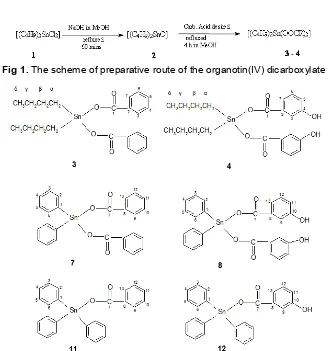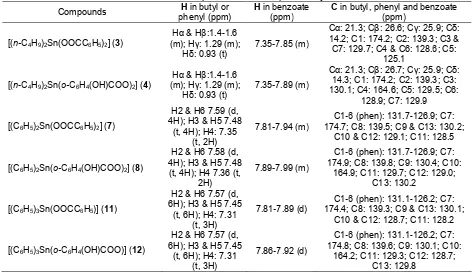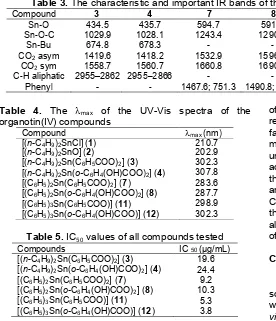IN VITRO
ACTIVITY AND COMPARATIVE STUDIES OF SOME ORGANOTIN(IV)
BENZOATE DERIVATIVES AGAINST LEUKEMIA CANCER CELL, L-1210
Sutopo Hadi*, Mita Rilyanti, and Suharso
Department of Chemistry, University of Lampung, Bandar Lampung 35145 Indonesia Received November 28, 2011; Accepted February 27, 2012
ABSTRACT
A series of dibutyl-, diphenyl- and triphenyltin(IV) benzoate derivatives has been prepared. The products were obtained by reacting the dibutyltin(IV) dichloride, diphenyltin(IV) dichloride and triphenyltin(IV) chloride respectively via the dibutyltin(IV) oxide, diphenyltin(IV) dihydroxide and triphenyltin(IV) hydroxide with benzoate acid and its derivative. The targeted compounds have been tested with anticancer activity against leukemia cancer cell, L-1210. The compounds synthesized were well characterized by1H and13C-NMR, IR and UV-Vis spectroscopies as well as based on the microanalytical data. The results showed that triphenyltin(IV) benzoate and its derivative prepared exhibit higher anticancer activity than those of dibutyltin(IV) and diphenyltin(IV) analogous.
Keywords:anticancer; IC50; leukemia cancer cell; organotin(IV) benzoates
ABSTRAK
Telah dibuat seri senyawa dibutil-, difenil- dan trifeniltimah(IV) dengan asam benzoat dan turunannya. Senyawa hasil diperoleh dengan mereaksikan berturut-turut dibutiltimah(IV) diklorida, difeniltimah(IV) diklorida dan trifeniltimah(IV) klorida melalui senyawa antara dibutiltimah(IV) oksida, difeniltimah(IV) dihidroksida dan trifeniltimah(IV) hidroksida dengan asam benzoat dan turunannya. Senyawa-senyawa yang dihasilkan kemudian diuji aktifitas antikankernya terhadap sel kanker leukemia L-1210. Senyawa-senyawa hasil sintesis dikarakterisasi dengan spektroskopi NMR 1H dan 13C, IR dan UV sinar tampak dan juga berdasarkan data mikroanalisis. Hasil penelitian menunjukkan bahwa senyawa trifeniltimah(IV) benzoat dan turunannya memberikan hambatan tertinggi pada uji antikanker dibandingkan senyawa sejenis dari dibutiltimah(IV) dan difeniltimah(IV).
Kata Kunci:antikanker; IC50; sel kanker leukemia; organotimah(IV) benzoat
INTRODUCTION
The structural chemistry of organotin carboxylates has attracted much attention due to their significant cytotoxic effect and relatively high antitumor activity [1-2]. The new development of these compound may lead for the development of new antitumor drugs, which can display another spectrum of antitumor activity [1,3]. The organotin(IV) compounds are known to display strong biological activity. Their compounds are normally exhibiting high toxicity, even at very low concentration. Their biological activities are fundamentally determined by the number and the nature of organic groups bound to the central Sn atom [4]. The nature of the anionic groups seems acting only as a secondary factor.
The current investigations on the coordinating properties of carboxylates toward organotin compounds have led to the isolation of some new organotin(IV) carboxylates and carboxylate derivatives which have shown some interesting biological activities such as antimicrobial [5-6], antitumor and anticancer [1,3,7-9],
and antifungal activity [6,10-12]. The investigation of organotin(IV) as possible antitumor compound has been and is still attracting much attention [1,3,7-9].
In the present work, we reported application, comparative and in vitro activity study of some dibutyl-, diphenyl- and triphenyltin(IV) benzoate and its derivatives against leukemia cancer cell, L-1210. EXPERIMENTAL SECTION
Materials
Radiation Technology, National Agency of Atomic Energy, Pasar Jumat, Jakarta, Indonesia.
Instrumentation
Elemental analysis (CHNS) was performed on Fision EA 1108 series elemental analyzer. IR spectra in the range of 4000-400 cm-1 were recorded on a Bruker VERTEX 70 FT-IR spectrophotometer with KBr discs. The UV spectra were recorded in the UV region and were measured using a UV-Shimadzu UV-245 Spectrophotometer. Measurements were performed in 1 mL quartz-cells. Solutions were prepared using methanol as the solvent with concentration of 1.0 x 10-4M.1H and 13C NMR spectra were recorded on a Bruker AV 600 MHz NMR (600 MHz for 1H and 150 MHz for 13C). All experiments were run in DMSO-D6 at 298 K. The number of runs used for 1H experiments were 32 with reference at DMSO signal at 2.5 ppm, while the 13C were 1000-4000 scans with the reference DMSO signal at 39.5 ppm.
Procedure
Preparation of organotin(IV) carboxylates
The organotin(IV) carboxylates used in this work and similar compounds with variety of benzoic derivatives as the ligands were prepared based on the procedure previously reported [9,11-12], and was adapted from the work by Szorcsik et al. [13]. An example procedure in the preparation of dibutyltin(IV) dibenzoate is as follows:
To 3.0383 g (0.01 mol) [(n-C4H9)2SnCl2] in 50 mL methanol was added 0.8 g (0.02 mol) NaOH. The reaction mixtures were stirred for about 45 min. Compound2 was precipitated out as white solid, filtered off and driedin vacuotill they are ready for analysis and further reaction. The average yield was 2.3508 g (95%).
To 0.37338 g (1.5 mmol) compound2 in 50 mL of methanol was added with 2 mole equivalents of benzoic acid and was refluxed for 4 h at 60–70 °C. After removal of the solvent by rotary evaporator, the produced compounds [(n-C4H9)2Sn(OOCR)2] were dried in vacuo until they are ready for analysis and further use for biological test. The average yields were more than ~90%.
A similar procedure was also adapted in the preparation of diphenyltin(IV) and triphenyltin(IV) derivatives, [(C6H5)2Sn(OOCR)2] and [(C6H5)3Sn(OOCR)], respectively. For triphenyltin(IV) only one mole equivalent of the carboxylic acid was added.
Bioassay anticancer activity test against leukemia cancer cell, L-1210
The in vitro anticancer activity test against leukemia cancer cell, L-1210 was performed based on the known procedure [9].1 mL of the cancer cells were added into each hole of multiwell plate tissue culture containing 2 x 106 cell/mL followed by the addition of 10 L of solution containing the compounds tested in methanol (if the sample was not soluble enough in the solvent used, before it is being added, the ultrasonic mixing was done first to homogenize the sample). The sample concentration variations used were 1, 2, 4, 6, 8, 16, 32 g/mL and three replicates per concentration were performed. As the negative control, the cell was treated with a solution containing 10 L of solvent was used as comparison. The cell was then incubated for 48 h in 5% CO2 incubator at 37 C. After being incubated, the sum of cell was counted in microscope using haemecytometer Fuch Rosental (0.200 mm x 0.0625 mm2).
The percentage of inhibition was calculated using the following formula in Eq. (1):
A
where A is the number of lives cell in medium tested; and B is the number of lives cell in control/blank.
Calculation of IC50
The IC50was calculated according to the adaption of Reed and Muench method which is an arithmetic method [14] and as following:
The data of all inhibition percentages were plotted into probit table to obtain each probit value of each analysis. The graph between log of concentration (x) and probity value (y) was then created to obtain a linier regression, y = a + bx. By inputting the probit value (y) = 5 (the probit of 50% value), then the value of x (log of concentration) was obtained. The IC50 value was then obtained by taking the anti log of x.
RESULT AND DISCUSSION
Preparation and characterization of organotin(IV) carboxylate compounds
Fig 1.The scheme of preparative route of the organotin(IV) dicarboxylate
Fig 2. The proposed structure of the compounds synthesized and the suggested numbering of carbons in each compound
obtained, the reactions in all cases were done via [(n -C4H9)2SnO] (2), [(C6H5)2Sn(OH)2] (6) and [(C6H5)3SnOH] (10) respectively similar to those previously reported [9,11-12]. The reaction occurred in each step for dibutyltin(IV) dicarboxylates, for example, is shown in Scheme 1. The microanalytical data of all compounds prepared are very good and all values obtained are close to the calculated values as shown in Table 1.
The characterizations of the targeted products synthesized were confirmed by some spectroscopy techniques. The 1H and 13C chemical shifts of the compounds prepared are shown Table 2. A number of signals in the spectra recorded have been characterized carefully. The chemical shift (δ) of butyl protons attached to the tin metal appeared in the range of 0.93 ppm for Hδ up to 1.4-1.6 ppm Hαand Hβ, and the carbons of butyl ligands are observed at position comparable with other similar compounds reported by other [15]. The chemical shift of phenyl protons attached to tin metal appeared in the range of 7.6–7.36 ppm, while the carbon of carboxyl group of all compounds as expected appeared in the region of 174 ppm [15, 16]. The carbon atoms of the phenyl ligand as also expected appeared in δ of
130–126 ppm, while the carbons in the benzoate derivatives appeared inδrange of 139–129 ppm close to the reported values of similar compounds [16].
The important FT-IR data and their assignments are presented in Table 3. The characteristic band of the starting materials (1, 5, 9) is the appearance of strong stretching band of Sn-Cl bond at 390–310 cm-1. As an example in the spectrum of 1, this bond appeared at frequency of 334.2 cm-1. The other characteristic bands of this compound appear as stretching band from butyl ligands at 1069 cm-1, and bending vibration of C-H aliphatic stretch of the butyl at frequency of 2956–2865 cm-1.
Table 1.The microanalytical data of the organotin(IV) compounds synthesized
Table 2.1H and13C spectra of the compounds synthesized Compounds Hin butyl or
phenyl (ppm)
Hin benzoate (ppm)
Cin butyl, phenyl and benzoate (ppm) 130.1; C4: 164.6; C5: 129.5; C6:
128.9; C7: 129.9 174.7; C8: 139.5; C9 & C13: 130.2;
C10 & C12: 129.1; C11: 128.5
[(C6H5)2Sn(o-C6H4(OH)COO)2] (8) 174.9; C8: 139.8; C9: 130.4; C10:
164.9; C11: 129.7; C12: 129.0; C13: 130.2 174.4; C8: 139.3; C9 & C13: 130.1;
C10 & C12: 128.7; C11: 128.2
[(C6H5)3Sn(o-C6H4(OH)COO)] (12) 174.8; C8: 139.6; C9: 130.1; C10:
164.2; C11: 129.3; C12: 128.7; C13: 129.8
by the strong asymmetric stretching bands of the carboxylates which occurred at ca. 1400 cm-1 and the symmetric stretch at ca. 1600 cm-1, confirming the success of the substitution reaction [9,11-12].
The UV-Vis spectroscopy analyses have also been taken for all the compounds used. The max of all the compounds is summarized in Table 4. From the data obtained (Table 3), it is clear that there was a shifting change in themaxfor each compound in any steps of the reaction. For example, the compound 1 has max of 210.7 nm, while compound2hasmaxof 202.9 nm. This information gave an indication that there was a shift to a shorter max value when the conversion of compound 1
Table 3.The characteristic and important IR bands of the organotin(IV) compounds (cm-1) synthesized
Compound 3 4 7 8 11 12 References
Sn-O 434.5 435.7 594.7 591.6 765.59 755.41 800-400
Sn-O-C 1029.9 1028.1 1243.4 1290.1 1243.36 1298.7 1050-900
Sn-Bu 674.8 678.3 - - - - 740-660
CO2asym 1419.6 1418.2 1532.9 1596.8 1558.8 1562.3 1600-1400 CO2sym 1558.7 1560.7 1660.8 1690.2 1631.36 1698.74 1700-1550
C-H aliphatic 2955–2862 2955–2866 - - - - 2960–2850
Phenyl - - 1467.6; 751.3 1490.8; 725.2 1428.7; 729.64 1430.2; 729.53 1450, 730
Table 4. The max of the UV-Vis spectra of the organotin(IV) compounds
Table 5.IC50values of all compounds tested
Compounds IC50(μg/mL)
chloride in 1, so the electron transition in this molecule will be easier (the energy required is less), thus producing longermax, 307.8 nm.
The antifungal activity of diorganotin(IV) and triorganotin(IV) compounds are well known, and many of their compounds have been synthesized for that purpose [6,10-12]. Some of the organotin(IV) compounds prepared have also been tested for antitumor activity and showed quite high antitumor activity [1,3,7-9].
In our previous study on the antifungal activity of the compounds reported here [11-12], it has been shown that optimal activity of the antifungal has been associated with the number of carbon atoms present in the organotin(IV) used [18], where in general, the derivative of triphenyltin(IV) carboxylate which contain 18 carbon atoms has smallest minimum inhibition concentration values in the series [11-12]. In this study interestingly the same phenomena was also observed.
Based on the data in Table 5, the derivatives of triphenyltin(IV) compounds has smaller IC50value in the series, and the diphenyltin(IV) compound has smaller IC50value than those of dibutyltin(IV) compounds. Thus the number of carbon atoms present has effect on the anticancer activity of the organotin(IV) tested. Besides that, the organotin(IV) carboxylate compounds synthesized have smaller IC50values compare to those
of starting materials and intermediate products. In this respect, our results are consistent with a well-known fact that many biologically active compounds become more active upon complexation than in their uncomplexed forms [19]. According to Crowe [20] the actual biological activity of diorganotin compounds of the type RR’SnXY (R and R’ = alkyl or aryl; X and Y = anions) is determined solely by the RR’Sn2+ moiety. Consequently the group X and Y would only influence the delivery of the active RR’Sn2+ ion to the cell, although it is not clear enough how is their mechanism of action.
CONCLUSION
It is quite clear from the discussion above that some promising organotin(IV) carboxylate compounds were successfully prepared and exhibited very high in vitro anticancer activity. The study of other organotin(IV) series which might have higher and better anticancer activity is still in progress. Thein vivotesting of the compounds synthesized against human cancer will also be undertaken to evaluate their possible use as an anticancer metal base-drug in the future.
ACKNOWLEDGEMENT
The authors would like to thank to The Directorate of Research and Services, Directorate General of Higher Education, The Ministry of Cultural and Education of Republic of Indonesia that provide fund for this project to be undertaken through Hibah Kompetensi Batch 2 Research Grant Scheme 2009
and 2011 with contract numbers of
254/SP2H/PP/DP2M/V/2009 and 364/SP2H/PL/Dit. Litabmas/IV/2011, respectively. Thanks also go to Prof. Bohari M. Yamin, Universiti Kebangsaan Malaysia for helping in doing microanalysis and Dr. Huy Hoang of Institute of Molecular Biosciences (IMB) University of Queensland, Brisbane, Australia for NMR experimentation.
REFERENCES
2. Gielen, M., 2003,J. Braz. Chem. Soc., 14, 6, 870– 877.
3. Zhang, Z-W., Jiang, T., Ren, S-M., Zhang, Y-X., and Yu, J-S., 2005,Chin. J. Chem., 23, 12, 1655–1658. 4. Pellerito, L., and Nagy, L., 2002,Coord. Chem. Rev.,
224, 111–150.
5. Bonire, J.J., Ayoko, G.A., Olurinola, P.F., Ehinmidu, J.O., Jalil, N.S.N., and Omachi, A.A., 1998, Met.-Based Drugs, 5, 4, 233–236.
6. Mahmood, S., Ali, S., Bhatti, M.H., Mazhar, M., and Iqbal, R., 2003,Turk. J. Chem., 27, 6, 657–666. 7. Li, Y., Li, Y., Niu, Y., Jie, L., Shang, X., Guo, J., and
Li, Q., 2008,J. Bioinorg. Chem., 102, 9, 1731–1735. 8. Rehman, W., Badshah, A., Khan, S., and Tuyet,
L.T.A., 2009, Eur. J. Med. Chem., 44, 10, 3981– 3985.
9. Hadi, S., and Rilyanti, M., 2010, Orient. J. Chem., 26, 3, 775–779.
10. Ruzika, A., Dostal, L., Jambor, R., Butcha, V., Brus, J., Cisarova, I., Holcapek, M., and Holecek, J., 2002, Appl. Organomet. Chem., 16, 6, 315–322.
11. Hadi, S., Irawan, B., and Efri, 2008, J. Appl. Sci. Res., 4, 11, 1521–1525.
12. Hadi, S., Rilyanti, M., and Nurhasanah, 2009,Mod. Appl. Sci., 3, 1, 12–17.
13. Szorcsik, A., Nagy, L., Gadja-Schrantz, K., Pellerito, L., Nagy, E., and Edelmann, E.T., 2002, J. Radioanal. Nucl. Chem., 252, 3, 523–530. 14. Turner, R.A., 1972, Screening Methods In
Pharmacology,New York, Academic Press, 60–72. 15. Nath, M., Yadav, R., Gielen, M., Dalil, H., de Vos, D., and Eng, G., 1997, Appl. Organomet.. Chem., 11, 727–736.
16. Li, Q., da Silva, F.M.C.G., and Pombeiro, A.J.L., 2004,Chem. Eur. J., 10, 6, 1456–1462.
17. Sudjadi, 1985, The Structure Determination of Organic Compounds, Ghalia Publishers, Indonesian, 327.
18. Chohan, Z.H., and Rauf, A., 1996, Synth. React. Inorg. Met.-Org. Chem.,26, 4, 591–604.


